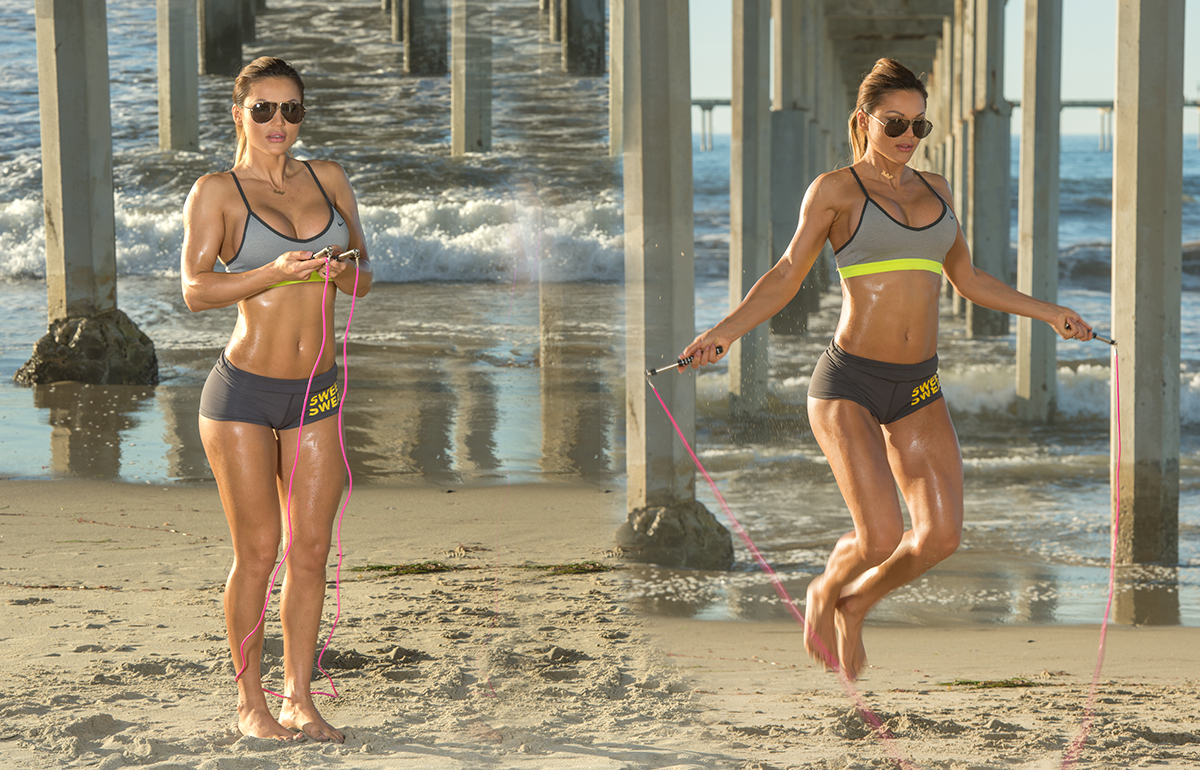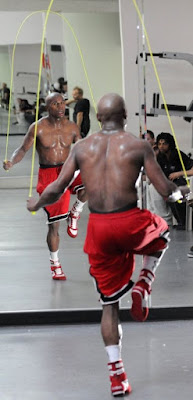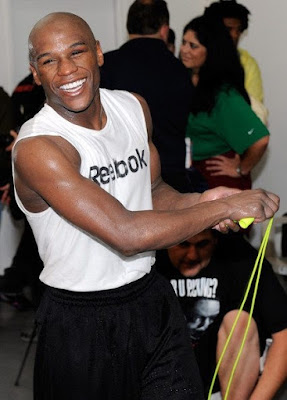CrossFit is one of the fastest growing sports today. CrossFit started in 2000 and has been growing steadily ever since, with over 5000 affiliates worldwide. CrossFit is a series of basic fundamental moves that are performed at high intensity requiring speed, strength, agility and endurance. Exercises included in CrossFit involve gymnastics, weightlifting running, rowing and skipping rope.
Skipping rope in CrossFit is one of the most challenging ways to skip rope. It can also help a person improve their performance in many other CrossFit exercises.

Initially, many of the participants were unable to complete the exercise because they were unprepared for how difficult it was. Skipping rope may be difficult, but if a person wants to be successful in CrossFit, this is an exercise that must be mastered: double unders are one of 7 exercises that have been included in every CrossFit Games Open and is included in the 2016 CrossFit Open as well.
When performing DU’s in competition, a person must complete a certain number without making a mistake. If they trip or have to stop they are required to start from the beginning. The number of DU’s a person must complete in competition can vary. The gold standard for double unders in CrossFit is being able to perform them nonstop for 2 minutes. However, many Workouts of the Day (WOD) only require performing 25-50 DU’s at a time. The general consensus is if a person can perform that many in training, it will probably suffice in a competition.
Many of the various CrossFit exercises require speed, coordination, balance, and explosive power. Double unders improve each of these and can be applied to other WOD exercises. DU’s also help to develop midline stability, which is a key component in the majority of CrossFit exercises.
Double unders are especially useful for Olympic lifting, cleans and the push press. These movements require explosive hip movements, which is developed when performing DU’s.
 Ropes come in different sizes. Here are tips on choosing the proper sized rope:
Ropes come in different sizes. Here are tips on choosing the proper sized rope:
A rope can also be chosen based on a person’s height:
Learn the basics.Being able to jump comfortably with singles is key. Practice jumping faster with single jumps to help improve timing, coordination and footwork. Aim for 100 jumps in 60 seconds or less.
Vary your speedPractice speeding up the rope and slowing it down without stopping. This teaches a person how to control the rope and their movements
Practice skipping and running in place.Skipping rope in this manner looks like a person is literally running in place. It will also help to increase footspeed:

Keep your hands low. Make sure your hands are below the ribcage and slightly in front of your torso. Raising the arms too high will raise the rope, causing it to catch on your feet.
Don’t kick your feet back. Jump straight up and straight down in the same spot to prevent tripping.
Work on timing. As the rope is coming down, be ready to jump quickly. Jumping too early will throw the timing off and cause a person to eventually trip.
Listen to the rhythm. Double unders have a distinct, repetitive sound: the rope hits the ground twice, then the feet hit the ground. The sound is constant and doesn’t change. Practice by listening for the beat.
Look forward. Keeping your head up and staring at one spot in front of you will help to keep the body in line. This will also help maintain focus and eliminate distractions.
Practice daily. The only way to master double unders is to practice daily.
Note: the weights listed are the maximum weight a person should use for that particular exercise. Less weight can be used for those unable to perform exercise with the weight lifted. Consult with a physician before performing any of these exercise.
CrossFit can push a person to their physical and mental limits. Being able to recover between exercises is key, and many competitors have been able to "rest" while doing double unders.
Here are tips on how to rest and recover while performing DU’s:
CrossFit is the ultimate challenge for many fitness enthusiasts. Mastering the jump rope and double unders in particular will help a person improve in all areas of CrossFit and get in excellent shape at the same time.
Check out DynaPro Direct’s range of professional grade fitness equipment to endure every part of your performance, then success is within your reach.
Skipping rope in CrossFit is one of the most challenging ways to skip rope. It can also help a person improve their performance in many other CrossFit exercises.

The Double-Under
When skipping rope for CrossFit, competitors must perform a "double under," or DU. A double under occurs when the rope passes under feet twice in one jump. Double unders made their CrossFit debut in 2001 and saw their popularity increase at a competition in 2009.Initially, many of the participants were unable to complete the exercise because they were unprepared for how difficult it was. Skipping rope may be difficult, but if a person wants to be successful in CrossFit, this is an exercise that must be mastered: double unders are one of 7 exercises that have been included in every CrossFit Games Open and is included in the 2016 CrossFit Open as well.
When performing DU’s in competition, a person must complete a certain number without making a mistake. If they trip or have to stop they are required to start from the beginning. The number of DU’s a person must complete in competition can vary. The gold standard for double unders in CrossFit is being able to perform them nonstop for 2 minutes. However, many Workouts of the Day (WOD) only require performing 25-50 DU’s at a time. The general consensus is if a person can perform that many in training, it will probably suffice in a competition.
Many of the various CrossFit exercises require speed, coordination, balance, and explosive power. Double unders improve each of these and can be applied to other WOD exercises. DU’s also help to develop midline stability, which is a key component in the majority of CrossFit exercises.
Double unders are especially useful for Olympic lifting, cleans and the push press. These movements require explosive hip movements, which is developed when performing DU’s.
Equipment: Choosing the Proper Rope
 Ropes come in different sizes. Here are tips on choosing the proper sized rope:
Ropes come in different sizes. Here are tips on choosing the proper sized rope:- Step on the center of the rope
- Pull the rope up to your armpits
- The edge of the rope should come up to your armpits
- Ideally the rope should be six to ten inches above your head when skipping
- Cable quality. Ropes usually have nylon or vinyl coatings. Nylon is the more popular of the two because it is durable and lasts longer.
- Comfort. The rope should have a good grip and turn quickly and smoothly.
- Lightweight. Double unders are a high intensity exercise that require the arms and wrists to move very quickly. To keep the upper body fresh, a lightweight rope is recommended.
- Durability. Being able to use the same rope both indoors and outdoors is a plus.
- Versatility. A rope may need to be adjusted slightly after a few workouts in order to obtain the optimum length. Purchasing a rope that may be resized is a wise investment.
A rope can also be chosen based on a person’s height:
| Length of Rope | Height of Jumper |
|---|---|
| 7 feet | 4'8" and under |
| 8 feet | 4'9" to 5'0" |
| 9 feet | 5'1" to 5'8" |
| 10 feet | 5'9" to 6'2" |
Mastering the Double Under
It takes time, practice and a lot of patience to master DU’s. Once a person has the proper rope, they can try the following tips:Learn the basics.Being able to jump comfortably with singles is key. Practice jumping faster with single jumps to help improve timing, coordination and footwork. Aim for 100 jumps in 60 seconds or less.
Vary your speedPractice speeding up the rope and slowing it down without stopping. This teaches a person how to control the rope and their movements
Practice skipping and running in place.Skipping rope in this manner looks like a person is literally running in place. It will also help to increase footspeed:
- Start with basic jump
- Increase the speed
- Raise right leg high as if running, with left leg low
- Raise left leg high with right leg low
- Take 5-10 single jumps
- Speed the rope considerably by whipping wrists forward
- Keeping legs straight, jump 2-3 inches higher than normal to ensure it goes under twice
- Perform single jumps for 3-5 repetitions
- Attempt another double under

Double unders require slightly different mechanics than single skips:
Use your wrists. The turning of the rope comes primarily from the wrists. Keep shoulder movements to a minimum.Keep your hands low. Make sure your hands are below the ribcage and slightly in front of your torso. Raising the arms too high will raise the rope, causing it to catch on your feet.
Don’t kick your feet back. Jump straight up and straight down in the same spot to prevent tripping.
Work on timing. As the rope is coming down, be ready to jump quickly. Jumping too early will throw the timing off and cause a person to eventually trip.
Listen to the rhythm. Double unders have a distinct, repetitive sound: the rope hits the ground twice, then the feet hit the ground. The sound is constant and doesn’t change. Practice by listening for the beat.
Look forward. Keeping your head up and staring at one spot in front of you will help to keep the body in line. This will also help maintain focus and eliminate distractions.
Practice daily. The only way to master double unders is to practice daily.
Double Under Routines
Here are a few great CrossFit routines that feature double unders1Note: the weights listed are the maximum weight a person should use for that particular exercise. Less weight can be used for those unable to perform exercise with the weight lifted. Consult with a physician before performing any of these exercise.
Routine #1
- 10 thrusters w/ 135 lbs max
- 50 double unders
- 8 thrusters w/ 135 lbs max
- 40 double unders
- 6 thrusters w/ 135 lbs max
- 30 double unders
- 4 thrusters w/ 135 lbs max
- 20 double unders
- 2 thrusters w/135 lbs max
- 10 double unders
Routine #2
- 50 double unders
- 21 kettlebell swings at 55 lbs. max
- 12 pull-ups
Routine #3
- 10 front squats w/155 max
- 50 double unders
- 8 front squats w/155 max
- 40 double unders
- 6 front squats w/155 max
- 30 double unders
- 4 front squats w/155 max
- 20 double unders
- 2 front squats
- 10 double unders
Routine #4
- 21 Box Jumps (or step ups)
- 50 Double Unders
- 15 Box Jumps
- 15 Push Press
Routine #5
- 50 Double Unders
- 9 Box Jumps
- 9 Push Press
- 50 Double Unders
Double Unders for Recovery
CrossFit can push a person to their physical and mental limits. Being able to recover between exercises is key, and many competitors have been able to "rest" while doing double unders.
Here are tips on how to rest and recover while performing DU’s:
- Jump higher. Jumping higher allows a person to slow down their double unders. The higher a person jumps, the less energy they will expend overall.
- Breathe. As a person’s conditioning improves, the body will become more efficient and use less energy when performing exercises like double unders. Deep breathing while performing double unders can help a person relax and get a little "rest" before the next exercise begins.
CrossFit is the ultimate challenge for many fitness enthusiasts. Mastering the jump rope and double unders in particular will help a person improve in all areas of CrossFit and get in excellent shape at the same time.
Check out DynaPro Direct’s range of professional grade fitness equipment to endure every part of your performance, then success is within your reach.



